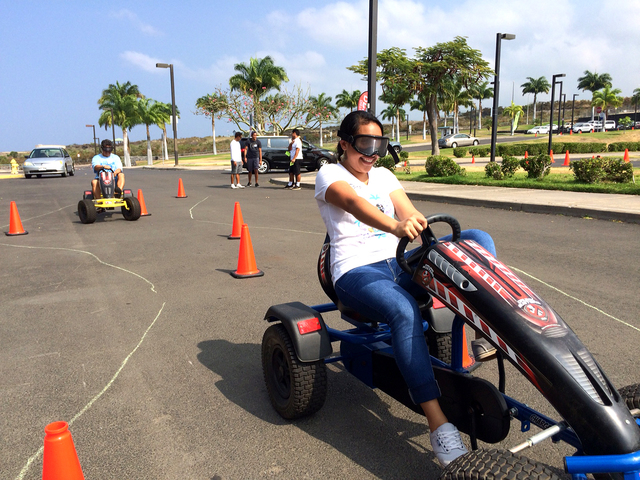KAILUA-KONA — As soon as Tera and Samuel Kekuaokalani slipped on the beer goggles, they knew they’d been had. ADVERTISING KAILUA-KONA — As soon as Tera and Samuel Kekuaokalani slipped on the beer goggles, they knew they’d been had. Their
KAILUA-KONA — As soon as Tera and Samuel Kekuaokalani slipped on the beer goggles, they knew they’d been had.
Their assigned task was simple to guide a pair of petal carts slowly through an obstacle course outlined with orange cones. But stuck behind special goggles that mimic the confused vision of a drunk driver, they found the job all but impossible.
The challenge was just one of many taking place at Kealakehe High School on Saturday morning as teens and their parents put themselves through the paces in an event designed to make them question what is possible and what is safe on the road.
Tera Kekuaokalani said the days line-up of activity — from driving while texting to parallel parking, emergency braking and seeing how small cars look from the cab of a tanker truck — have helped her to see “there’s more than just you on the road.”
“Once you’re out there on the road, you’re holding other people’s lives in your hands,” the high school senior said.
She looked back at her father, who had mowed down two cones with his own cart.
“There’s no way,” he laughed.
Back when the school drivers education teacher Larry Verble was growing up, people didn’t commonly wear seat belts. Air bags didn’t exist; people frequently rode piled in the back of pickup trucks. Most of that has changed, but progress has brought with it a lot of other risks. Verble breaks it down this way:
“The biggest problems now are distractions within the car. They’re talking to each other, talking and texting on cell phones, changing CDs. And there’s a lot more cars on the road now.”
As one driver practiced weaving an obstacle course while texting and sending a selfie, Verble played the part of a child lobbing a ball into the street in front of the car.
“It’s much better to make the mistakes in a controlled situation rather than do it in real life and have someone get killed,” he said.
Six teens die on U.S. highways every day, a figure that helped prompt the Department of Education to launch the statewide “Stop If You Love Me” campaign to raise awareness of driving pitfalls and ways to stay safe on the road.
Saturday’s “Operation Driver Excellence” event, sponsored by the DOE, DTRIC Insurance and Par Hawaii, was one aspect of that campaign. It has taken place on Oahu for almost three decades, but this was the first time the challenge had been held in West Hawaii, said Jan Meeker, resource teacher for the Hawaii State Driver Education Program.
“This is really a hands-on experience for the parent and child within their own car,” Meeker said.
The program is a half-day reality check which Meeker hopes will become more popular in coming years as the word gets out. The event drew two dozen parents and teens. While the turnout was less than what was hoped for, it allowed participants to take a relaxed pace and even repeat the exercises.
At highway speeds, you travel the length of a football field while sending a five-word text, said Cindy Bagley, a drivers education teacher at Konawaena High School. Bagley spent much of Saturday morning checking cars into the distracted driving course and watching them scatter cones.
“They literally can’t do it,” she said. “They’re learning that they have to have 100 percent attention, and both hands on the wheel.”



